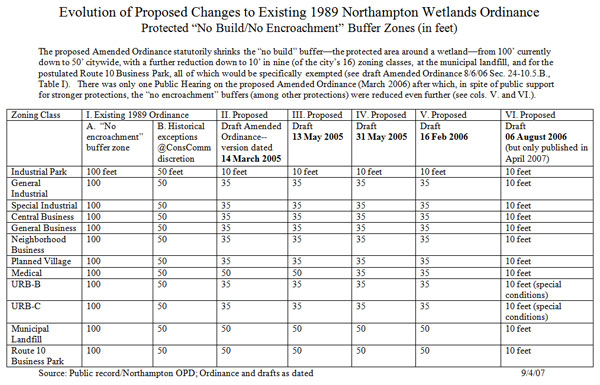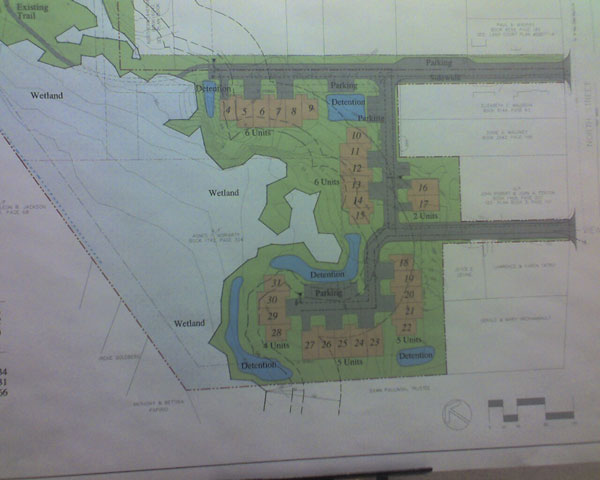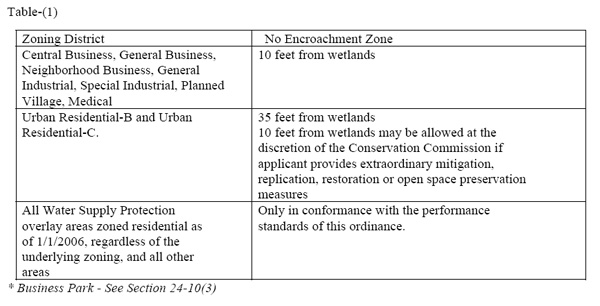Randall Arendt presents Model Ordinance Provisions for Conservation Subdivision Design in “Growing Greener: Conservation Subdivision Design”, an article published in Planning Commissioners Journal, Winter 1999. This model ordinance underscores just how far Northampton’s new Wetlands Ordinance, which encourages development to within 10 feet of wetlands in the 15% of the city that is most built-up, has diverged from best practice…
Excerpts from Model Ordinance Provisions for Conservation Subdivision Design
Minimum Percentage of Open Space
The minimum percentage of land that shall be designated as permanent open space, not to be further subdivided, and protected through a conservation easement…
A minimum of fifty percent (50%) of the total tract area, after deducting the following kinds of unbuildable land…
wetlands… floodway and floodway fringe within the 100-year floodplain… land with slopes exceeding 25%, or soils subject to slumping… land required for street rights-of-way (10%) of the net tract area… land under permanent easement prohibiting future development…
Primary Conservation Areas.
This category consists of wetlands, lands that are generally inundated (under ponds, lakes, creeks, etc.), land within the 100-year floodplain, slopes exceeding 25%, and soils subject to slumping…
Secondary Conservation Areas.
…shall include all or part of the following kinds of resources: mature woodlands, aquifer recharge areas, areas with highly permeable (“excessively drained”) soil, significant wildlife habitat areas, sites listed on the [state natural areas inventory], prime farmland, historic, archaeological or cultural features listed (or eligible to be listed) on national, state or county registers or inventories, and scenic views into the property from existing public roads. Secondary Conservation Areas therefore typically consist of upland forest, meadows, pastures, and farm fields, part of the ecologically connected matrix of natural areas significant for wildlife habitat, water quality protection, and other reasons…
Evaluation Criteria
…the Planning Commission shall evaluate proposals to determine whether the proposed conceptual preliminary plan…
Designs around existing hedgerows and treelines between fields or meadows, and minimizes impacts on large woodlands (greater than five acres), especially those containing many mature trees or a significant wildlife habitat…
House sites should generally be located not closer than 100 feet from Primary Conservation Areas, but may be situated within 50 feet of Secondary Conservation Areas, in order to enjoy views of the latter without negatively impacting the former…
See also:
Hyla Ecological Services Analyzes the Proposed Wetlands Ordinance
“Buffers of less than 50 feet in width are generally ineffective in protecting wetlands. Buffers larger than 50 feet are necessary to protect wetlands from an influx of sediment and nutrients, to protect wetlands from direct human disturbance, to protect sensitive wildlife species from adverse impacts, and to protect wetlands from the adverse effects of changes in quantity of water entering the wetland… (Castelle et al., ‘Wetland Buffers: Use and Effectiveness’, 1992)
“Buffer function was found to be directly related to the width of the buffer. Ninety-five percent of buffers smaller than 50 feet suffered a direct human impact within the buffer, while only 35% of buffers wider than 50 feet suffered direct human impact. Human impacts to the buffer zone resulted in increased impact on the wetland by noise, physical disturbance of foraging and nesting areas, and dumping refuse and yard waste. Overall, large buffers reduced the degree of changes in water quality, sediment load, and the quantity of water entering the adjacent wetland.” (Castelle et al., 1992)
Gazette opinion: “Don’t ease controls on wetlands” (10/25/07)
Proponents of Northampton’s new wetlands buffer zone regime, which authorizes development as close as 10 feet to wetlands in nine zoning districts, tried to reassure critics by saying developers wouldn’t automatically be entitled to get that close. The reality, however, is Northampton’s Conservation Commission will now be on the defensive whenever it asks developers for more than the minimum specified in the new ordinance. Alexandra Dawson, chair of Hadley’s Conservation Commission, writes in today’s Gazette [emphasis added]:
I thoroughly agree with recent comments to the effect that this is not the time to weaken local controls over development in or near wetlands. Few cities and towns outside Route 495 have local wetlands protection ordinances and bylaws; so what happens to one is likely to happen to others. This is clearly what has happened in Northampton and Greenfield…
…Northampton has adopted changes to its bylaws that limit the setback between development and wetlands in the business district to 10 feet, although it is obvious that 10 feet is not even enough space to accommodate the big yellow machines that do the building. It is true that a recent court decision indicates that wetlands ordinances (or conservation commission regulations adopted under them) should enumerate setbacks so that builders need not guess what will be required of them. Unfortunately, there is also case law stating that whatever is so established limits the commission’s discretion to ask for more unless there is a specific showing of why one proposal stands out from the others. If the setback in the ordinance is 10 feet, it will be very hard for the commission to justify a permit restricting building for 50 feet. For this reason, most eastern Massachusetts bylaws that contain setbacks start at 25 to 50 feet.
Gazette: “Council adopts wetlands ordinance”
At-large City Councilor James M. Dostal proposed an amendment Thursday that called for increasing the 10 feet no-encroachment zones in urban residential districts to 50 feet because of serious concerns about homes flooding, saying “We shouldn’t be building there…”
The proposed ordinance is not consistent with past practice, and favors substantial new encroachments on Northampton’s wetlands
[This article dates from before the new Wetlands Ordinance was enacted]
Under the current ordinance, could the Conservation Commission permit developers to encroach to within zero feet of a wetland? Sure, but it would be in clear violation of the intent of the ordinance. Objectors would have a strong case in court. This is worlds apart from the proposed new ordinance, which positively invites developers to encroach within 10 feet of wetlands in several districts:
To encourage infill development, which is considered more sustainable under the principals of smart growth and generally has a smaller environmental footprint than development in outlying areas, in the Central Business, General Business, Highway Business, Neighborhood Business, General Industrial, Special Industrial, Planned Village, Medical, Urban Residential-B and Urban Residential-C zoning districts, within those portions of the Water Supply Protection overlay district which was zoned industrial as of 1/1/2006, the Conservation Commission hereby waives any of the Section 24-10 performance standards that are over and above state law with the exception of the setback requirements in Table (1). The reduced setback requirements in Table (1) shall apply…
The following chart makes clear that the proposed ordinance is not consistent with past practice, that it favors substantial new encroachments on Northampton’s wetlands, and that recent revisions have made it ever more lopsided in favor of developers:

Note: Public officials have given us to understand that at least one permit to encroach within 10 feet of wetlands has been issued in the Industrial Park district in recent years. Nevertheless, we believe that a 50-foot no-build buffer zone has been the more general rule.
Our Response to Jim Levey’s Letter to the Gazette
While the existing regulations may have permitted developers to encroach to within zero feet of wetlands, in practice this has been rare. For example, a review of the Conservation Commission’s minutes from 2004 (PDF) finds the following:
In the case of Dudanake NOI, 12/9/04, the applicant proposed to disturb 26% of a 50-foot buffer. The minutes report: “Sweetser asked if the NCC has ever permitted a project with this much disturbance. Body and Carbin said no.”
Paved Surfaces, Salt and Water Bodies: A Bad Mix
Let’s recall that Kohl Construction’s proposed condo development off North Street calls for paved surfaces [and condos] as close as 35 feet or less from the wetlands surrounding Millyard Brook.

Photo Essay: Millyard Brook Swells with Water in Winter
